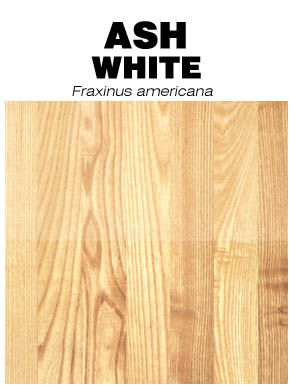 |
Appearance
Color: Heartwood is
light tan to dark brown; sapwood is creamy white. Similar in
appearance to white oak, but frequently more yellow.
Grain: Bold, straight,
moderately open grain with occasional wavy figuring. Can have
strong contrast in grain in plainsaw boards.
Variations within species and
grades: Sometimes confused with hickory; the zone of
large pores is more distinctive in ash, similar to that of red
oak. |
 |
 |
Appearance
Color: Heartwood is
mostly reddish brown; sapwood is generally pale white
Grain: Mostly closed,
straight grain; fine, uniform texture. Coarser than European
beech.
Variations within species and
grades: Only one species is native to the United States.
Moderate to high color variation between boards. |
 |
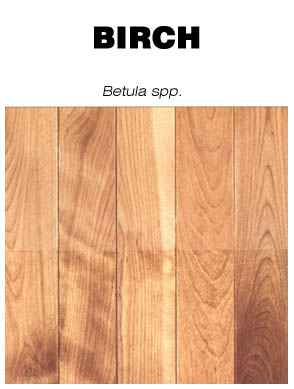 |
Appearance
Color: In yellow birch,
sapwood is creamy yellow or pale white; heartwood is light
reddish brown tinged with red. In sweet birch, sapwood is light
colored and heartwood is dark brown tinged with red.
Grain: Medium figuring,
straight, closed grain, even texture. Ocassional curly grain or
wavy figure in some boards.
Variations within species and
grades: Yellow birch, sweet birch, paper birch. Paper
birch is softer and lower in weight and strength than yellow or
sweet birch. However, yellow birch is most commonly used for
flooring. Boards can vary greatly in grain and color. |
 |
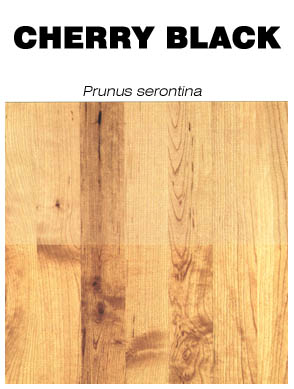 |
Appearance
Color: Heartwood is
light to dark reddish brown, lustrous; sapwood is light brown to
pale with a light pinkish tone. Some flooring manufacturers
steam lumber to bleed the darker heartwood color into the
sapwood, resulting in a more uniform color.
Grain: Fine, frequently
wavy, uniform texture. Distinctive flake pattern on true
quartersawn surfaces. Texure is satiny, with some gum pockets.
Variations within species and
grades: Significant color variation between boards. |
 |
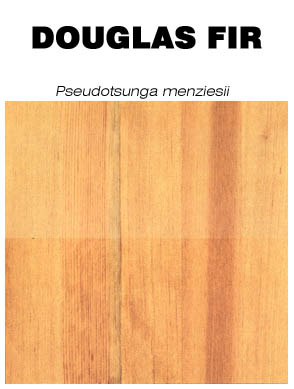 |
Appearance
Color: Heartwood is
yellowish tan to light brown. Sapwood is tan to white. Heartwood
may be confused with that of Southern yellow pine. Radical color
change upon exposure to sunlight.
Grain: Normally
straight, with occasional wavy or spiral texture. Nearly all fir
flooring is vertical-grain or riftsaw clear-grade material.
Variations within species and
grades: Wood varies greatly in weight and strength. Young
trees of moderate to rapid growth have reddish heartwood and are
called red fir. The narrow ringed wood of old trees may be
yellowish brown and is known as yellow fir. |
 |
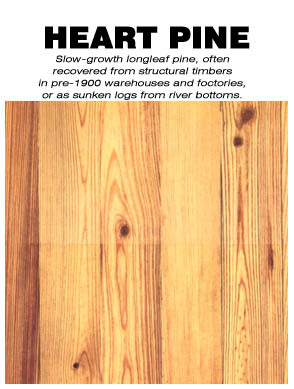 |
Appearance
Color: Heartwood is
yellow after cutting and turns deep pinkish tan to warm reddish
brown within weeks due to high resin content. Sapwood remains
yellow, with occasional blue-black sap stains.
Grain: Dense, with high
figuring. Plainsaw is swirled; rift or quartersawn is primarily
pinstriped. Curly or burl grain is rare.
Variations within species and
grades: Moderate color variation. |
 |
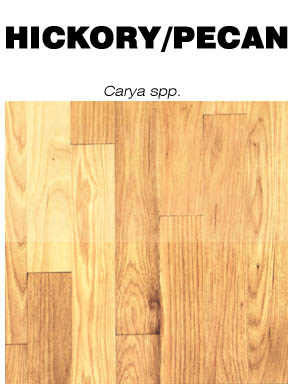 |
Appearance
Color: Pecan heartwood
is reddish brown with dark stripes; sapwood is white or creamy
white with pinkish tones. Hickory heartwood is tan or reddish;
sapwood is white to cream, with fine brown lines.
Grain: Pecan is open,
occasionally wavy or irregular, Hickory is closed, with moderate
definition; with a somewhat rough texture.
Variations within species and
grades: In both hickory and pecan, there are often
pronounced differentiations in color between spring wood and
summer wood. In pecan, sapwood is usually graded higher than
darker heartwood. Pecan and hickory are traditionally mixed by
flooring mills. |
 |
 |
Appearance
Color: Heartwood is
creamy white to light reddish brown; sapwood is pale to creamy
white.
Grain: Closed, subdued
grain, with medium figuring and uniform texture. Occasionally
shows quilted, fiddleback, curly or bird’s eye figuring. Figured
boards often culled during grading and sold at a premium.
Variations within species and
grades: Black maple is also hard; other species are
classified as soft. |
 |
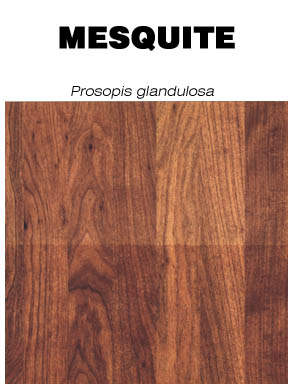 |
Appearance
Color: Light brown to
dark reddish brown.
Grain: High in
character, with ingrown bark and mineral streaks. Most commonly
used in flooring as end-grain block, which has small irregular
cracks radiating across the grain.
Variations within species and
grades: One grade; moderate color variations. |
 |
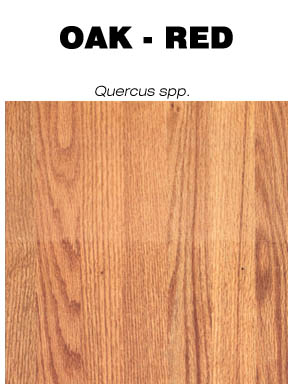 |
Appearance
Color: Heartwood and
sapwood are similar, with sapwood lighter in color; most pieces
have a reddish tone. Slightly redder than white oak.
Grain: Open, slightly
coarser than white oak. Plainsaw boards have a plumed or flared
grain appearance; riftsawn has a tighter grain pattern, low
figuring; quartersawn has a flake pattern, sometimes called
tiger rays or butterflies.
Variations within species and
grades: More than 200 subspecies in North America; great
variation in color grain. depending on the origin of the wood
and corresponding differences in growing seasons. Northern,
Southern and Appalachian red oak can all be divided into upland
and lowland species. |
 |
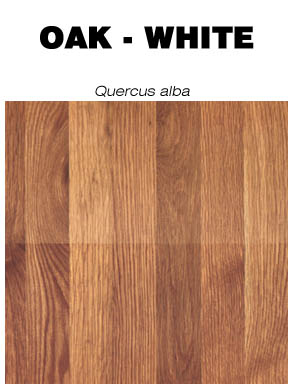 |
Appearance
Color: Heartwood is
light brown; some boards may have a pinkish tint or a slightly
grayish cast. Sapwood is white to cream.
Grain: Open, with longer
rays than red oak. Occasionally crotches, swirls and burls.
Plainsawn boards have a plumed or flared grain appearance;
riftawn has a tighter grain pattern, low figuring; quartersawn
has a flake pattern, sometimes called tiger rays or butterflies.
Variations within species and
grades: Considerable variation among boards in color and
grain texture, but variations not as pronounced as in red oak. |
 |
 |
Appearance
Color: Heartwood varies
from light yellow/orange to reddish brown or yellowish brown;
sapwood is light tan to yellowish white.
Grain: Closed, with high
figuring; patterns range from clear to knotty.
Variations within species and
grades: Longleaf pine, shortleaf pine, loblolloy pine,
slash pine. All have many of the same characteristics as Douglas
fir. Old-growth lumber in these varieties has substantially
higher density and is more stable than second-growth material. |
 |
 |
Appearance
Color: Heartwood ranges
from a deep, rich dark brown to a purplish black. Sapwood is
nearly white to tan. Difference between heartwood and sapwood
color is great; some flooring manufacturers steam lumber to
bleed the darker heartwood color into the sapwood, resulting in
a more uniform color.
Grain: Mostly straight
and open, but some boards have burled or curly grain.
Arrangement of pores is similar to hickories and persimmon, but
pores are smaller in size.
Variations within species and
grades: Great variety of color and figure within species,
as well as variation in color among boards, especially in lower
grades and from material that isn’t steamed prior to kiln
drying. |
 |
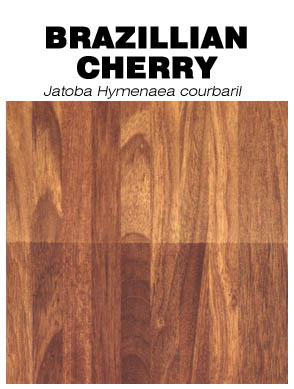 |
Appearance
Color: Sapwood is gray-white;
heartwood is salmon red to orange-brown when fresh, and becomes
russet or reddish brown when seasoned; often marked with dark
streaks.
Grain: Mostly
interlocked; texture is medium to rather coarse.
Variations within species and
grades: Moderate to high color variation. |
 |
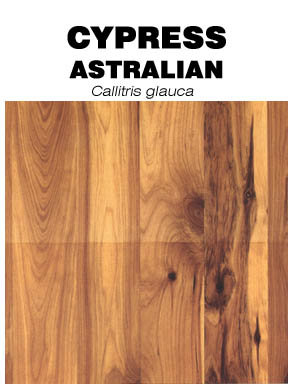 |
Appearance
Color: Cream-colored
sapwood; heartwood is honey-gold to brown with darker knots
throughout.
Grain: Closed.
Variations within species and
grades: High degree of color variability. |
 |
 |
Appearance
Color: Heartwood is
uniformly pinkish to dark red, often rich, dark red mahogany
hue, turning a deep brownish red with age and exposure; sapwood
is pale. Frequently black streaks with occasional ingrown grain.
Grain: Frequently
interlocked or wavy. Texture is even and moderately coarse.
Variations within species and
grades: Moderate to high color variation. |
 |
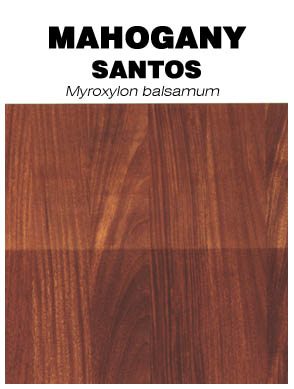 |
Appearance
Color: Dark reddish
brown.
Grain: Striped figuring
in quartersawn selections; texture is even and very fine.
Variations within species and
grades: Moderate color variation. |
 |
 |
Appearance
Color: Heartwood is
yellowish to orange-brown when freshly cut, turning brown to
dark red-brown upon exposure.
Grain: Straight to
interlocked or wavyl coarse texture.
Variations within species and
grades: Moderate to high variation in color. |
 |
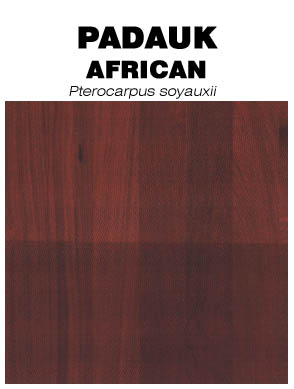 |
Appearance
Color: Heartwood is
vivid reddish orange when freshly cut, darkening to reddish or
purple-brown or black over time. Sapwood is cream-colored. Very
uniform in color.
Grain: Straight to
interlocked; coarse texture.
Variations within species and
grades: Slight variation in color. |
 |
 |
Appearance
Color: Heartwood is
brown when freshly cut, turning deep purple to purplish brown
over time. Sapwood is a lighter cream color.
Grain: Usually straight;
medium to fine texture.
Variations within species and
grades: Moderate to high color variation. |
 |
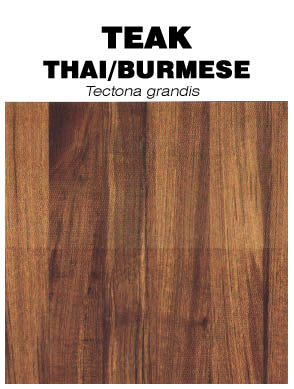 |
Appearance
Color: Heartwood varies
from yellow-brown to dark golden brown; turns rich brown under
exposure to sunlight. Sapwood is a lighter cream color.
Grain: Straight; coarse,
uneven texure.
Variations within species and
grades: Moderate to high color variation. |
 |
 |
Appearance
Color: Heartwood is
yellow-brown when freshly cut, turning dark brown to almost
black with alternate layers of light and dark. Sapwood is
yellowish-white and clearly demarcated from heartwood.
Grain: Straight when
quartersawn; coarse texture.
Variations within species and
grades: Moderate variation in color. |
 |






















